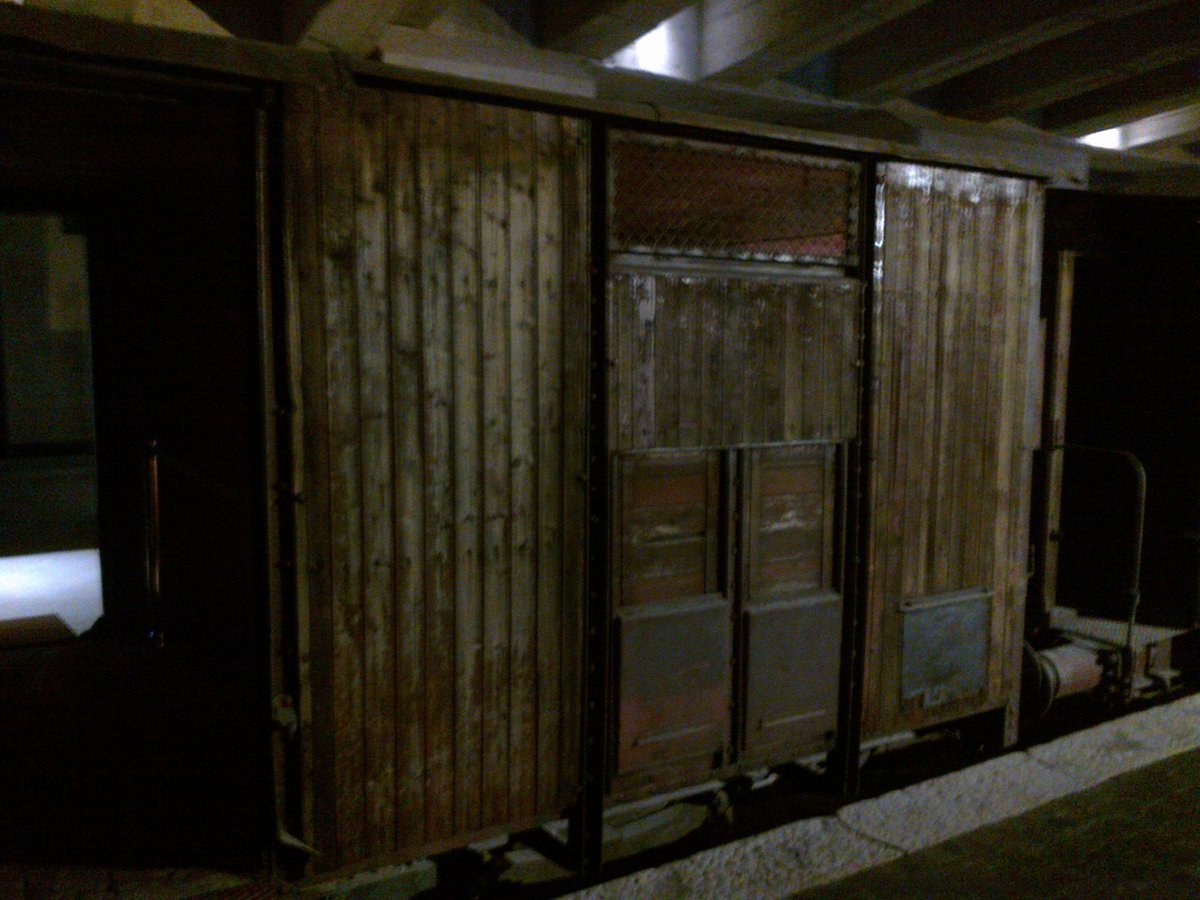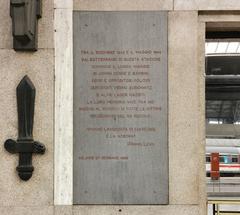
Holocaust Memorial Milan: Visiting Hours, Tickets, and Historical Significance
Date: 15/06/2025
Introduction
The Memoriale della Shoah di Milano, or Holocaust Memorial Milan, stands as a profound testament to the city’s wartime history and the enduring importance of remembrance. Situated beneath Milano Centrale railway station, this memorial preserves the clandestine Platform 21 (Binario 21), from which thousands of Jews and other persecuted groups were deported during World War II. The site serves as both a solemn commemorative space and an educational hub, enabling visitors to reflect on the tragedies of the Holocaust and Milan’s role in these events. This comprehensive guide covers the memorial’s history, cultural significance, practical visiting details, travel tips, accessibility information, and nearby attractions to help you plan a meaningful visit.
Table of Contents
- Introduction
- Historical Background
- Visiting the Memoriale della Shoah di Milano
- Nearby Attractions
- Frequently Asked Questions (FAQ)
- Visuals and Media
- Useful Internal and External Links
- Conclusion
- Call to Action
- References
Historical Background
Origins and Historical Context
The Memoriale della Shoah di Milano occupies a site of immense historical significance beneath the city’s Central Station (Stazione Centrale). From December 1943 to January 1945, Platform 21 (Binario 21) was used as a secret departure point for the deportation of Jews, political dissidents, and other persecuted individuals to Nazi concentration and extermination camps, including Auschwitz-Birkenau, Mauthausen, and Bergen-Belsen. The area was originally designed for postal wagons, hidden from public view—enabling the fascist authorities and Nazi occupiers to conduct deportations without attracting public attention. Many prisoners were transferred from San Vittore prison to this underground platform and transported in cattle cars to their tragic destinations (Atlas Obscura; Mentelocale).
Deportations from Milan: Key Events and Numbers
The first convoy left Platform 21 on December 6, 1943, carrying 169 Jewish prisoners—of whom only five survived. The second major convoy departed on January 30, 1944, with 605 people; just 22 returned. In total, thousands of individuals—Jews, political opponents, leftists, homosexuals, and people with disabilities—were deported from this site during the Nazi occupation of northern Italy. The memorial preserves the original platform, cattle cars, and other historical elements, serving as a powerful reminder of these events (Mentelocale; Atlas Obscura).
Visiting the Memoriale della Shoah di Milano
Opening Hours and Tickets
- Regular Hours: Monday to Thursday and Saturday to Sunday, 10:00 am – 4:00 pm (last entry at 3:30 pm).
- Closed: Fridays and annually from August 8th to 29th.
- Special Free Entry: Last Friday of each month, 10:00 am – 6:00 pm (last entry at 5:30 pm).
- Ticket Prices:
- Adults: €10
- Students and Seniors (over 65): €5
- Children up to 5, accompanying groups, and disabled persons: Free
- Family Ticket: Two adults and two minors pay only for adults; minors enter free
- Discounts: La Rinascente card holders receive 20% off individual tickets
- Booking: Tickets can be purchased on-site or reserved online. Advance booking is highly recommended for guided tours and during peak periods (Memoriale Shoah - Tickets).
How to Get There
- Address: Piazza Edmond J. Safra 1 (formerly via Ferrante Aporti 3), beneath Milano Centrale.
- Metro: M2 (green) and M3 (yellow) lines to Stazione Centrale or M2 to Caiazzo.
- Trolleybus: Lines 90-91 and 92.
- On Foot: Follow signs for “Memoriale della Shoah” within the station (Memoriale Shoah - How to Find Us).
Accessibility
- Physical Access: Step-free access with elevators and ramps.
- Facilities: Restrooms and cloakroom available.
- Languages: Exhibits are in Italian; audioguides and select materials available in English and other languages.
- For Visitors with Disabilities: The site is fully accessible, and staff are trained to assist.
Guided Tours and Special Events
- Guided Tours: Available for individuals and groups, lasting approximately 45–60 minutes (max 50 participants). Private group tours (min 15 people) can be booked via [email protected].
- Audioguides: Available in multiple languages for self-guided visits.
- Special Events: Commemorative events on Holocaust Remembrance Day (January 27) and other significant dates. Check the official website and social media for schedules.
What to Expect During Your Visit
Main Areas
- Track 21 (Binario 21): The original deportation platform, with restored cattle cars.
- Wall of Names: Installation listing those deported from Milan.
- Memory Lab: Educational and research space for Holocaust studies.
- Hall of Records: Video testimonies and archival materials.
- Interactive Exhibits: Multimedia stations with documents, photos, and survivor stories, including those of Liliana Segre (Life in Italy; TripHobo).
Typical Visit Duration: 1 to 1.5 hours. Guided tours last 45–60 minutes, with time for reflection recommended.
Visitor Etiquette
- Dress Code: Modest attire is encouraged.
- Photography: Allowed without flash or tripods; always respect posted signs and the solemn atmosphere.
- Behavior: Maintain quiet and respectful conduct.
- Children: Supervision recommended; some content may be emotionally intense.
Travel Tips and Practical Information
- Weather: Milan is prone to sudden rain; bring appropriate clothing (SoloSophie - Milan Travel Tips).
- Nearby Dining and Accommodation: Many options are available within and near Stazione Centrale (TripHobo).
- Bag Checks: Security screening at entrance; large bags may need to be stored.
- Language: Basic Italian phrases can enhance your experience.
- Stay Updated: Follow the memorial’s Facebook, Instagram, and YouTube for news and event updates.
Nearby Attractions
- Museo della Resistenza (Museum of the Resistance)
- Duomo di Milano (Milan Cathedral)
- Museo del Novecento (Museum of Twentieth Century Art)
- Galleria Civica d’Arte Moderna
- Chiesa di San Fedele
These sites provide further opportunities to explore Milan’s rich historical and cultural heritage.
Frequently Asked Questions (FAQ)
Q: How can I purchase tickets?
A: Tickets are available on-site and online. Advance booking is recommended, especially for guided tours.
Q: Are discounts available for students or seniors?
A: Yes, students and those over 65 pay €5; children under 5 and disabled visitors enter free.
Q: Is the memorial wheelchair accessible?
A: Yes, with step-free access, elevators, and adapted restrooms.
Q: When is the best time to visit?
A: Weekdays are generally less crowded; the last Friday of the month offers free entry with extended hours.
Q: Can I take photos inside?
A: Photography is permitted without flash or tripods; always check for specific restrictions.
Q: Are guided tours offered in English?
A: Yes, both guided tours and audioguides are available in multiple languages, including English.
Visuals and Media
Useful Internal and External Links
- Memoriale della Shoah di Milano (Official Website)
- Atlas Obscura - Shoah Memorial of Milan
- Mentelocale - Memoriale della Shoah Milano
- TripHobo - Memoriale della Shoah di Milano
- Life in Italy - Memories of the Italian Holocaust
- SoloSophie - Milan Travel Tips
- Visit Milan - Official Tourism Site
Conclusion
The Memoriale della Shoah di Milano is a vital site for remembrance, education, and historical reflection. Its authentic setting beneath Milan’s Central Station, detailed historical exhibits, and accessible facilities make it a must-visit for anyone wishing to engage meaningfully with Milan’s past and the universal lessons of the Holocaust. By planning ahead, booking tickets or tours in advance, and approaching your visit with respect, you ensure a powerful and informative experience.
Call to Action
Plan your visit to the Memoriale della Shoah di Milano using this guide and the official resources provided. For enhanced experiences, download the Audiala app, subscribe to the memorial’s social channels, and explore related articles to further your understanding of Milan’s historical sites. Your visit supports ongoing educational efforts and honors the memory of those lost.
References
- Atlas Obscura
- Mentelocale
- Memoriale della Shoah di Milano - Official Website
- TripHobo
- Life in Italy
- SoloSophie - Milan Travel Tips
- Visit Milan





























































